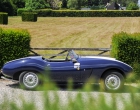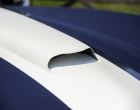Specifications
- Brand
-
Arnolt-Bristol
- Model
-
Bolide
- Construction year
- Mileage
-
30269 km
- Fuel
-
Gasoline
- Transmission
-
Manual
- Color exterior
-
Blue
- Power
- 96 kW / 130 HP
- Bodywork
-
Convertible
Show all specifications | Download pdf
- Color group exterior
-
Blue
- Cylinder capacity
-
1971cm3
- Cylinders count
-
6
- Doors count
-
2
- Drive type
-
Rear
- Gears count
-
4
- Has carpass
-
No
- Interior color
-
Red
- Is metallic
- Interior color
-
Red
- Seats count
-
2
- Upholstery
-
Full leather
Description
Arnolt-Bristol Bolide Deluxe Roadster 1954 (ex-Hugh Hefner, Playboy founder)
- Coachwork by Carrozzeria Bertone
- Chassis no. 404/X/3105
- Engine no. BS1/MKII/302
- Matching numbers
- 1 of only 142 made built
- First owner Hugh Hefner, founder of Playboy, with same owner for over 30 years
- Desirable original color configuration: Paramatti Blue with Beige interior
- Fully documented historical file
- Eligible for all races worldwide; Mille Miglia, Le Mans, Goodwood, Spa…
Ownership history
1954 Wacky Arnolt
1957 Hugh Hefner, who offered it to one of his bunnies
… Jack Zallinger, USA
1979/12/27 Imported into UK by Brian Classic Ltd, car was silver, low mileage, and still wearing its 1954 Firestone tyres
1982/06/01 First registration in UK
1983/08/20 Jonathan Bradburn, through company Bradburn Bros Ltd., 41 Birmingham Road, Wolverhampton, WV2 3LP, UK, car had 3.841 miles.
1984/02/15 John Reeder, 29 Chester Way, London, UK. Number plate 6068 DH, car is red.
1991/7/15 Adrien de Ghellinck d’Elseghem, Rue A. Collin 8, 1330 Rixensart, bought for £1600, via Dan Margulies for J.M. Agace.
1992/05/21 M.J., Brussels, Belgium
1994/10/18 Y.V., Brussels, Belgium, car was light blue with black interior
Description & details on car
Having made his fortune during WW2, Chicago-based industrialist Stanley Harold 'Wacky' Arnolt II
was able to indulge his lifelong love of automobiles, and by 1952 was a regional BMC distributor and US
distributor for Bristol cars. In 1952, a visit to Carrozzeria Bertone led to Arnolt buying a stake in the Italian
company and arranging manufacture of Bertone-bodied Arnolt MGs. Bertone's elegant coupé and cabriolet
on the MG TD chassis had been first exhibited at the 1951 Geneva Salon. These cars were enthusiastically
received by Arnolt, who saw the Bertone-bodied TD as meeting the US market's requirement for a
luxury MG; a car possessing that all-important octagon badge yet blessed with something above the Spartan
level of equipment usually associated with the Abingdon marque's sports cars. Two hundred cars were
ordered, though production eventually totalled 65 coupés and 37 cabriolets.
Arnolt's next venture made use of the Bristol connection, the UK manufacturer's 404 chassis getting
the Bertone treatment in 1953 courtesy of newly arrived stylist, Franco Scaglione. Despite being based
on a pre-war BMW design, the Bristol possessed one of the finest chassis of its day, and its 2.0-litre six-cylinder
engine was one of the most efficient around. The 1,971cc Bristol six was based on that of the pre-war
BMW 328, which featured an ingenious cylinder head, designed by Rudolf Schleicher, incorporating hemispherical
combustion chambers and inclined valves without recourse to overhead, or twin, camshafts. Instead, the
earlier BMW Type 319 engine's single block-mounted camshaft and pushrod valve actuation were
retained, thus avoiding an expensive redesign. Two rocker shafts were employed, one situated above each
bank of valves, giving the engine an external appearance almost indistinguishable from that of a
twin-overhead-cam design. Downdraft inlet ports contributed to the motor's deep breathing, and its tune-ability
made it a popular choice for British racing car constructors, most notably Cooper, during the 1950s. Externally,
Bristol's clone of the BMW motor differed little from the German original, the most obvious difference being the
adoption of SU, rather than Solex, carburettors part way through production. The most significant changes
made by the Bristol designers were metallurgical, their utilisation of the highest quality materials contributing to greatly increased engine life.
The engine's one drawback, from a packaging perspective, was its height. Nevertheless, Scaglione still
managed to come up with a sleek looking sports car, first by incorporating a bonnet scoop and secondly
by employing sharply creased contours over the front wings to draw the viewer's attention away from the
bonnet's unusually tall centre. Three open models were offered ranging from the basic competition version
via the better-appointed Bolide to the fully equipped Bolide Deluxe. There was also an enclosed coupé. Arnolt
charged $3,995 for the competition model, $4,245 for the Bolide, $4,995 for the Bolide Deluxe, and $5,995 for the coupé.
The Bristol engine could be tuned to produce in excess of 150bhp, and before long the pretty Arnolts were
making their mark in production sports car races in the USA. After class wins at Sebring and Le Mans in
1955, the works team was disbanded following the fatal accident that claimed the life of driver
Bob Goldich, returning to Sebring in 1960 to capture class and team awards yet again. Arnolt-Bristol production
ceased in 1963 after a total of 130 cars had been sold out of 142 produced (the other 12 were destroyed in
a fire at the factory).
One of a relative handful of roadworthy survivors, chassis number '3105' – a late and more expensive
Bolide Deluxe model - was delivered new to Playboy magazine founder, Hugh Hefner. Reportedly, Wacky Arnolt
was friends with Hugh Hefner and gifted this car to him.
In 1990, this example was featured in an article in Classic & Sports Car magazine's May
edition: "Jonathan Bradburn bought this car, chassis 404X3105, in the early eighties from Jack Zallinger
in the USA, who confirmed the tale that is was given to Hugh Hefner of Playboy fame by Wacky. Considering
that it was built in 1954 and not registered until 1960, you get the feeling that Wacky wasn't a brilliant
salesman when it came to getting rid of Arnolt-Bristols, so he had to resort to parting with them as gifts. Some
present! However, it seems that Hefner himself gave it away as well to one of his Bunnies, so you also get
the feeling that he wasn't wildly taken with it." It is believed the aforementioned 'Bunny' immediately sold the car on.
When Jonathan Bradburn had bought '3105' it had only 6,000 genuine miles on the clock and was still on
its original tyres! The Arnolt was registered in the UK as '6068 DH' and repainted red. Following Jonathan
Bradburn's ownership, the Arnolt passed to John Reeder in London and then in 1987 to Jeremy Agace, still in
the UK. It then relocated to Belgium, being owned by Adrien de Ghellinck d'Elseghem (1991), a lady owner
(1992), last owner (1994 up to today).
The date of first registration is documented as 15/09/1953, although this seems to have been chosen by
the registration authorities as the car is known to have been built in 1954, like most of the
Arnolt-Bristols, and delivered to S.H. Arnolt in the US only in 1958 before being first registered in 1960!
This Arnolt-Bristol Deluxe Roadster is said to be a late production model. The year 1953 is also quoted in
various items of correspondence on file.
The chassis plate records the original colour as Paramatti Blue with beige interior, the car was repainted
in its original colour in 1992, and following its purchase by the current vendor in 1994 was re-sprayed
again, on this occasion to dark blue with a white stripe, the livery it is presented in today. The last owner
has cherished this car for nearly 30 years, using it regularly and participating in numerous international
rallies. Having enjoyed driving the Arnolt-Bristol over many thousands of kilometres.
Documents that accompany the car
Large history file starting in 1979 with numerous documents (invoices, import documents, purchase contracts, clippings, etc)
Arnolt-Bristol brochure (original)
Instruction manual for the Bristol Type 406 (original)
1957 Playboy magazine featuring a drawing of the car in its original colors (original)
Vehicle registration doculent UK (dated 1984)
H.S.C.C. Vehicle Identity form (dated 1979)
RAC historic vehicle identity form (dated 1988)
Belgian registration document (dated 1992)
Historical Vehicle Club of Belgium (FIVA) certificate in the last owner's name (dated 1995)
Current Belgian road registration documents
Unique history, eligible for all major events worldwide, ready to driven and enjoyed by its new owner.
More pictures available
Visible only on appointment
For further informations , please contact us +32 (0)2 681 81 00 & sales@british-sportscars.com






































































